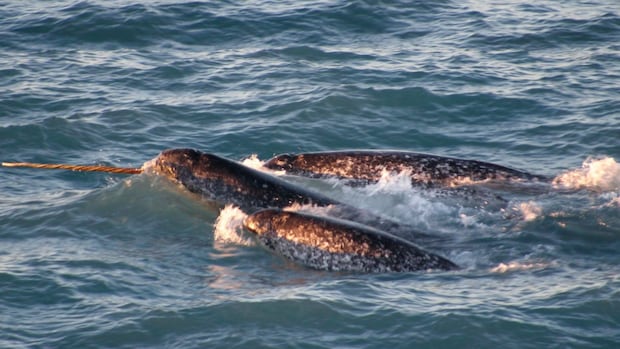New research on narwhals in Nunavut’s Eclipse Sound suggests the animals may be more sensitive to shipping noise than scientists previously believed, and that they change their behaviour when ships are nearby.
The study, published earlier this month in the journal Nature, says narwhal stop echolocating and will vacate an area when exposed to low-pitched ship noise. It also says the marine mammals are sensitive to sounds more than 20 kilometres away.
“It seemed to be an understood fact prior to our research that narwhal were only affected in close range, but when you speak to the hunters and the elders, that’s just not been the case,” said Alex Ootoowak, a researcher from Pond Inlet, Nunavut, and one of the co-authors of the study. He is with the Oceans North acoustic monitoring program.
The study backs up hunters’ observations around mining projects in the region, such as the now-closed Nanisivik mine, and their belief that narwhals are more sensitive to shipping noise than existing marine shipping noise guidelines recognize, said Ootoowak.
“People seem to appreciate that our research is proving what’s long been understood and known here,” said Ootoowak.
The research will be used to assess and mitigate impacts of mine shipping, cruise ships and yachts trying to enter the Northwest Passage, he said.
For the last decade, Oceans North partnered with Pond Inlet’s Mittimatalik Hunter Trappers Organization (MHTO) and the California-based Scripps Institution of Oceanography to study how narwhal react to ship noise in Eclipse Sound, near Pond Inlet, where they return each summer to feed in deep, plentiful waters.
According to the new study, narwhal numbers in Eclipse Sound in summer appear to have declined by about 90 per cent in the last two decades, from an estimated 20,200 animals in 2004 to 2,081 animals in 2021.
Ootoowak calls the change over the years “sad.” As a teenager, his dad would take him on long trips to hunt and live off the land. The waters were so plentiful that sleep would be an issue.
“You’re just constantly hunting and watching and enjoying the views of hundreds and hundreds of narwhal pass by,” he said.
“I want the later generations to see what I saw,” he said.

The researchers also state that between 2015 to 2019, there was a 384 per cent increase in the number of vessels transiting through the Eclipse Sound — with 80 per cent of those vessels connected to regional mining activity, and the other 20 per cent to tourism.
Inuit hunters in the region were the first to notice the changes in narwhal surface behaviour and population numbers as the first shipments of ore went out from Baffinland’s Mary River Mine in 2015, said Kristin Westdal, science director at Oceans North and another of the report’s co-authors.
She said narwhal were spending less time diving, a behaviour usually indicative of feeding, and changing direction of travel when they encounter a ship. The data can help answer the question of how much noise is too much for the animals, she said.
“It’s interesting and also alarming when you can pinpoint that position at which the animals stop talking or disappear from that habitat,” she said.
The research will inform the interim management plan for Tallurutiup Imanga National Marine Conservation Area, as well as future protected areas, according to Westdal. She said it will also be used by the Nunavut Impact Review Board when looking at projects like the Mary River Mine.
Studying echolocation
The researchers used echolocation clicks of narwhals and satellite data to measure the distance of ships from their recorders. They analyzed how narwhal responded to the sound of ships passing through the area.
“These echolocation clicks are associated with important functions like foraging, finding food or navigating,” said Joshua Jones, a project scientist overseeing the research with Oceans North and the MHTO.
Previous studies found impacts within 10 kilometres of ships, and “strong avoidance” among narwhals of areas within one kilometre of passing ships, the study states.
The new research suggests narwhals are even more sensitive to sound than other species they’ve been compared to such as killer whales or dolphins, and show behavioural changes when ships are within 20 kilometres, said Jones.

Narwhals are sensitive to noise below 1 kHz, said Jack Ewing, staff research associate at Scripps Institution of Oceanography at the University of California in San Diego and another of the report’s co-authors. That’s a lower pitch than previous research has suggested the animals were senstive to.
Narhwals also react to broadband sound pressure levels well below 120 dB, Ewing said.
“These sound levels are relevant for assessing noise impacts moving forward,” Ewing said.







